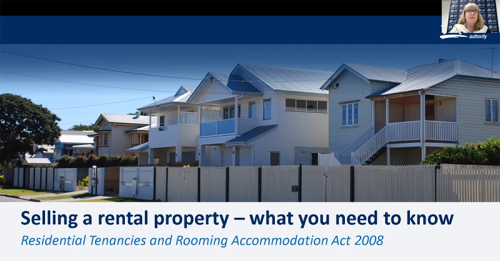A tenancy agreement does not automatically end when a rental property is sold. The buyer takes on any agreement in place before taking ownership.
Selling the property
- The property manager/owner must give the tenant a Notice of lessor's intention to sell premises (Form 10), which includes how they plan to market the property.
- The property manager/owner may also request to take photographs of the property for advertising purposes, and request to organise viewings.
- If the selling agent is different from the property manager, the selling agent must give the property manager a copy of each Entry notice (Form 9) or Entry notice (Form R9) for rooming accommodation before entering the property.
- An open house or on-site auction can only be held if the tenant agrees in writing.
- If a property manager/owner serves a Notice to leave (Form 12) or if a tenant/resident issues a Notice of intention to leave (Form 13), a property owner/manager cannot enter the property more than twice within a 7-day period.
- The property manager/owner must ensure the tenant has quiet enjoyment of the property.
Once the property is sold
An attornment notice (i.e. a letter) must be given to the tenant advising them of the new property owner, the new owner’s details and where to pay rent. Property managers/owners must offer tenants/residents at least 2 options to pay rent. A Change of property manager/owner (Form 5) is given to the RTA to update the property manager/owner's details for the bond record.
Fixed term agreements
If the tenant is on a fixed term agreement, the property manager/owner cannot make them leave because they have decided to sell. The tenant can stay until the end of their fixed term, and the new owner will become their property owner. Sometimes a property manager/owner will negotiate with a tenant to end the agreement early and may offer some form of compensation.
Periodic agreements
If the tenant is on a periodic agreement, and the buyer does not want to continue renting the property (i.e. they want vacant possession of the property), the property manager/owner must give the tenant a Notice to leave (Form 12) or Notice to leave (Form R12) for rooming accommodation, that must allow at least 2-months notice after the contract of sale is signed.
Limits apply to entry frequency after a Notice to Leave (Form 12) or Notice of intention to leave (Form 13) is issued. For more information visit our Entry to the property web page.
Rent increases
A change of property manager or owner does not affect the 12-month rent increase frequency limit. The buyer cannot increase the rent unless it has been at least 12 months since the current amount of rent became payable for the property.
Tenant has just moved in or signed a new agreement
If the property is advertised for sale or the property manager/owner enters to show the property to a prospective buyer during the first 2 months of an agreement (including a new agreement), and the tenant was not given written notice of the proposed sale before entering into the agreement, the tenant can end the agreement by giving a Notice of intention to leave (Form 13) with 2 weeks notice.
The tenant must give the property manager/owner the notice within 2 months and 2 weeks of the start of the tenancy.
Caravan parks
If a caravan park is being sold but the tenancies are continuing, the outgoing property owner must advise the tenants of the change of ownership with an attornment notice (i.e. a letter).
Tenants must also be given the name and service address of the new owner and rent must be paid to the new property manager/owner. Any unpaid rent at the time of the transfer of ownership is a debt owed to the previous owner.
The previous owner may pass the right to collect this debt on to the new owner.
If the property is put up for sale within 2 months of a tenancy starting and the tenant was not informed of the intention to sell at the time of signing the agreement, the tenant has the option of ending the agreement with 2 weeks notice.
The tenant must give the property manager/owner a Notice of intention to leave (Form 13) within 2 months and 2 weeks of the start of the tenancy.
Mortgagee repossessing a rental property
A mortgagee (usually a bank or financial institution) may seek to end a tenancy agreement and take possession of a rental premises if all the following applies:
- the premises are subject to a mortgage
- after the premises became subject to a mortgage, the residential tenancy agreement was entered into
- the mortgagee does not consent to the tenancy
- the mortgagee or another person appointed under the mortgage has become entitled to obtain possession of the premises.
The mortgagee must give the tenant at least 2 months to leave (30 days for rooming accommodation), using a Notice to vacate from mortgagee to tenant (Form 19) or Notice to vacate from mortgagee to tenant (Form R19) for rooming accommodation.
If the mortgagee had agreed to the tenancy, they can end a periodic agreement with 2 months notice, but cannot end a fixed term agreement earlier than the end date unless the tenant agrees.

Selling a rental property


